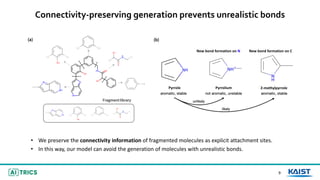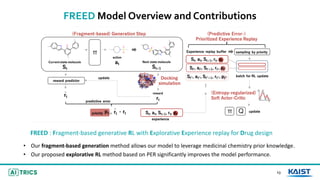Hit and Lead Discovery with Explorative RL and Fragment-based Molecule Generation
- 1. Hit and Lead Discovery with Explorative RL and Fragment-based Molecule Generation SoojungYang, Doyeong Hwang, Seul Lee, Seongok Ryu, Sung Ju Hwang AITRICS and KAIST
- 2. Screening library Hits Chemical space Automated small molecule drug discovery Hits • Searching for novel hits is a critical task in drug discovery. 2 Hits • Molecules with high therapeutic potential • High binding affinity to a given protein target Small molecule Protein target + ➞ Protein-ligand complex ΔG = binding free energy
- 3. Automated small molecule drug discovery • Searching for novel hits is a critical task in drug discovery. • RL methods can be used for automated hit search. Screening library Hits RL agent Chemical space 3
- 4. Automated small molecule drug discovery Screening library Hits • Searching for novel hits is a critical task in drug discovery. • RL methods can be used for automated hit search. • Molecular docking simulation estimates protein-ligand binding affinity. • We can guide RL agents with docking scores as reward. RL agent Docking simulation score reward Chemical space 4
- 5. Drug molecules should satisfy strong structural constraints ➝ Few examples of structural alerts in PAINS filter. • Drug molecules should not have toxic or highly reactive substructures. • Widely-used medicinal chemistry filters include several hundreds of diverse structural alerts. Hits Chemical space High-quality hits 5
- 6. Drug molecules should satisfy strong structural constraints • Previous molecular generative models guided by implicit methods cannot entirely avoid inappropriate structures. • e.g., multi-objective optimization where total reward = docking score reward + structure penalty reward ➠ Explicit method to constrain the generation space within acceptable molecules are necessary. “Fragment-based molecular generation” Hits Chemical space High-quality hits 6
- 7. Our fragment-based molecular generation method 7 Pharmacochemcially acceptable fragment library Action 1 Next state molecule St+1 Action 2 Action 3 Augmented fragment Possible attachment sites Current state molecule St
- 8. Markovian embedding and policy network makes the model plausible for hit generation and scaffold-based generation 8 • The embeddings of the molecule and fragments are autoregressively passed onto the policy network. • State embedding network and policy network are Markov models. • Any arbitrary molecule can be the current state. ➠ The model can be used for scaffold-based generation as well as hit generation.
- 9. Connectivity-preserving generation prevents unrealistic bonds 9 • We preserve the connectivity information of fragmented molecules as explicit attachment sites. • In this way, our model can avoid the generation of molecules with unrealistic bonds. Pyrrolium Pyrrole Pyrrolium 2-methylpyrrole New bond formation on N New bond formation on C
- 10. Explorative RL algorithm improves model performance in the strongly constrained generation space 10 Chemical space RL agent Acceptable chemical spaces Good exploration • Strong constraint in generation space makes search space less smooth ➠ Solutions can be trapped in local optima. • A practical drug discovery model should find as many diverse optimal areas in the chemical space. Our strategies • Employ soft-actor-critic (SAC), an off-policy actor-critic algorithm based on maximum entropy RL, which encourages exploration. • Devise explorative algorithms based on prioritized experience replay (PER) method.
- 11. 11 priority pt • Goal: Sample-efficient exploration • Priority is a measure of how much additional information we can learn from the transition. • Pt = TD error of agent’s value estimate (Q or V function) [Schaul et al.] Original PER priority pt Our PER algorithm encourages the agent to visit novel states [Schaul et al.] Prioritized Experience Replay, ICLR 2016
- 12. 12 priority pt • Goal: Sample-efficient exploration • Priority is a measure of how much additional information we can learn from the transition. • Pt = TD error of agent’s value estimate (Q or V function) [Schaul et al.] Original PER • Goal: Encourage sufficient diversity • Priority is a measure of the novelty of the state • PER(PE) Pt = predictive error of reward estimator • PER(BU) Pt = Bayesian uncertainty of reward estimate Ours: PER(PE), PER(BU) Our PER algorithm encourages the agent to visit novel states [Schaul et al.] Prioritized Experience Replay, ICLR 2016 reward rt reward predictor rt ^ priority pt = rt ^ - rt predictive error
- 13. FREED Model Overview and Contributions 13 • Our fragment-based generation method allows our model to leverage medicinal chemistry prior knowledge. • Our proposed explorative RL method based on PER significantly improves the model performance. FREED : Fragment-based generative RL with Explorative Experience replay for Drug design
- 14. Experimental results 14 fa7 protease parp1 polymerase 5ht1b G protein-coupled receptor Three protein targets Evaluation metrics Quality score (filter score) : ratio of accepted, valid molecules to total generated molecules Hit ratio : ratio of unique hit molecules to total generated molecules, where hit is defined as molecules who have higher docking scores than the median of known active molecules Top 5% score : average docking score of top 5%-scored generated molecules * Higher = greater absolute value Baseline models MORLD : atom-wise generative model + MolDQN REINVENT : SMILES-based generative model + REINFORCE
- 15. Results 1 – Explicit constraints are necessary to avoid problematic structures 15 • Our fragment-based generation model successfully avoids structural alerts. • Baseline models trained to avoid alerts in multi-objective optimization scheme show suboptimal results.
- 16. Results 2 – Our model outperforms the unconstrained models 16 • Our model outperforms or at least show comparable performance with the unconstrained baseline models. Hit ratio Top 5% score better better
- 17. Result 3 – Our PER method shows the best performance 17 Hit ratio Top 5% score better better
- 18. Result 3 – Our PER method shows the best performance 18 • All explorative algorithms outperform the vanilla SAC and PPO. • Our PER(PE) and PER(BU) outperform previous algorithms such as PER(TD) and curiosity-driven algorithms. Hit ratio Top 5% score better better
- 19. Result 4 – Hit and scaffold-based generation case study 19 Hit generation Scaffold-based (lead) generation • Initial structure: a benzene ring • Initial structure: a scaffold extracted from known active molecules
- 20. Result 4 – Hit and scaffold-based generation case study 20
- 21. Summary 21 • Our model FREED is a novel RL framework for real-world drug design that couples a fragment-based molecular generation strategy with a highly explorative RL algorithm. • FREED can generate pharmacochemically acceptable molecules with high docking scores. • When we want to avoid many structural alerts, explicitly constraining the molecular generation space is more effective than implicit methods. • By defining priority as the novelty of the state, PER method can encourage the model exploration to find many optima in highly-constrained molecular generation space.










![11
priority pt
• Goal: Sample-efficient exploration
• Priority is a measure of how much additional information
we can learn from the transition.
• Pt = TD error of agent’s value estimate (Q or V function)
[Schaul et al.] Original PER
priority pt
Our PER algorithm encourages the agent to visit novel states
[Schaul et al.] Prioritized Experience Replay, ICLR 2016](https://image.slidesharecdn.com/neurips2021hitandleaddiscoverywithexplorativerlandfragment-basedmoleculegeneration-211206043615/85/Hit-and-Lead-Discovery-with-Explorative-RL-and-Fragment-based-Molecule-Generation-11-320.jpg)
![12
priority pt
• Goal: Sample-efficient exploration
• Priority is a measure of how much additional information
we can learn from the transition.
• Pt = TD error of agent’s value estimate (Q or V function)
[Schaul et al.] Original PER
• Goal: Encourage sufficient diversity
• Priority is a measure of the novelty of the state
• PER(PE) Pt = predictive error of reward estimator
• PER(BU) Pt = Bayesian uncertainty of reward estimate
Ours: PER(PE), PER(BU)
Our PER algorithm encourages the agent to visit novel states
[Schaul et al.] Prioritized Experience Replay, ICLR 2016
reward
rt
reward predictor
rt
^
priority pt = rt
^
- rt
predictive error](https://image.slidesharecdn.com/neurips2021hitandleaddiscoverywithexplorativerlandfragment-basedmoleculegeneration-211206043615/85/Hit-and-Lead-Discovery-with-Explorative-RL-and-Fragment-based-Molecule-Generation-12-320.jpg)








